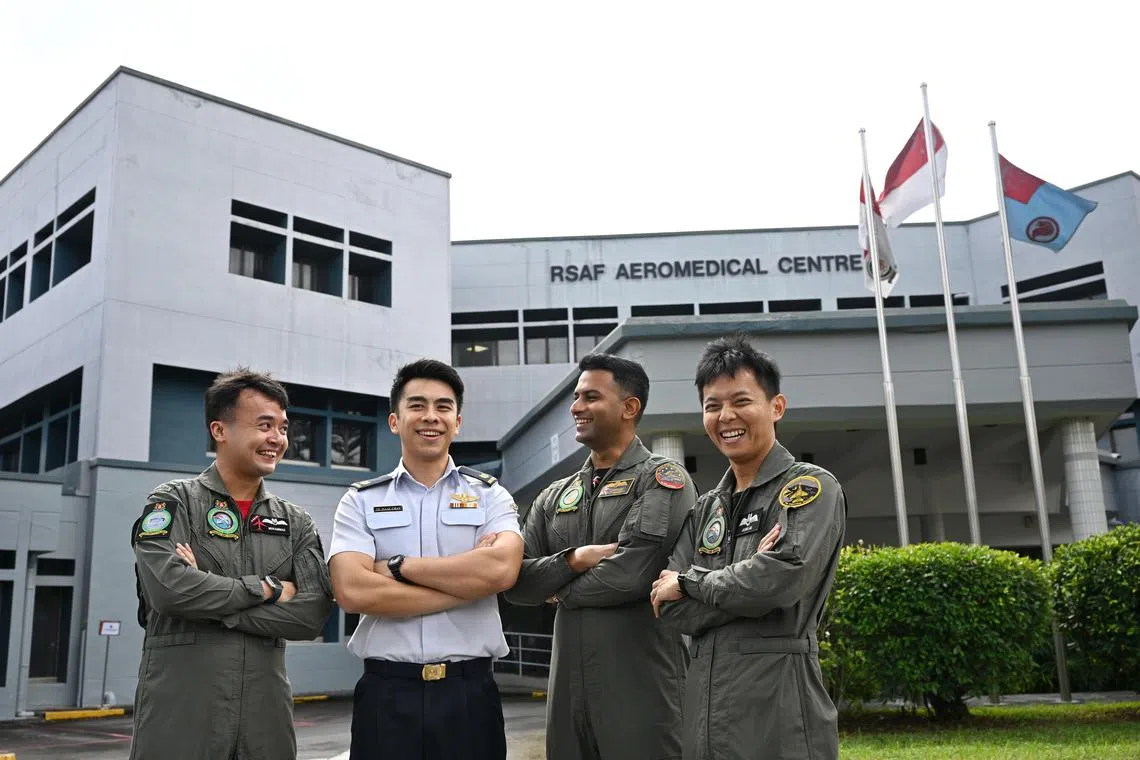More than 400 RSAF pilots had vision correction surgery since 2005
Sign up now: Get ST's newsletters delivered to your inbox

Options are now available to prospective military pilots who do not have perfect vision, including identifying possible candidates for corneal refractive surgery.
ST PHOTO: SHINTARO TAY
Follow topic:
SINGAPORE – Surgery to correct vision problems has widened the recruiting pool for the Republic of Singapore Air Force (RSAF), with more than 400 military pilots sponsored to receive such treatments over the past two decades.
Procedures such as Lasik will be even more necessary to maintain a viable talent pool for the air force in the years to come, with as many as nine in 10 Singaporean adults expected to be myopic by 2050, RSAF medical officer Isaac Chay said on Jan 26.
The media briefing at the RSAF Aeromedical Centre in Paya Lebar Air Base was aimed at dispelling the myth that perfect eyesight is required to be a military pilot, while shedding light on the ways the service maintains its aircrew’s vision.
Since 2005, the RSAF has offered corneal refractive surgery (CRS) to correct myopia free of charge to suitable candidates, allowing them to pursue a military flying career.
The air force realised then that there was a need for such a service as more and more prospective pilots would be myopic, said Major (Dr) Chay, 31.
An RSAF study found that one-fifth of pilot applicants across an eight-year period until 1991 had been unable to meet eyesight standards. Even after the standards were relaxed, more than one in 10 hopefuls in the subsequent eight years were still medically disqualified because of myopia, according to a 2017 article in Mindef’s defence journal Pointer.
“We wanted to offer our military pilots, our military aircrew, the chance to embark on a career without the need to wear spectacles, and in doing so enhance their ability to perform their flying duties both safely and effectively,” said the trainee eye specialist at the RSAF Aeromedical Centre.
To be a military pilot, myopia in candidates must not be more than 800 degrees per eye, and astigmatism must be less than 300 degrees per eye.
The RSAF first offered only photorefractive keratectomy (PRK) to candidates, and in 2013 began offering the newer laser-assisted in situ keratomileusis (Lasik) technology as an additional option for those requiring refractive surgery.
While both use lasers to alter the shape of the cornea to correct errors of refraction that result in myopia, Lasik has a shorter recovery period as it does not involve the removal of the top layer of the cornea, unlike PRK.
Such procedures can cost more than $4,000 here.
A 2014 study by researchers from the RSAF Aeromedical Centre of 76 RSAF personnel who had undergone the PRK procedure found that 98.5 per cent had perfect vision a year after surgery.
However, it is not compulsory for military pilots to undergo corrective surgery.
They may wear spectacles while they fly, but their glasses must be aviation grade – meaning they must be scratch-proof and have anti-glare coating – as well as be compatible with the headgear worn during flights.
Lieutenant-Colonel Jason Lau, who underwent PRK in 2012, said that wearing glasses under a flight helmet could cause discomfort, and there was also the risk of glasses fogging up during flights.
The F-16 fighter pilot stressed the importance of good eyesight during missions.

(From left) Transport pilot Muhammad Mohamad Nasir, medical officer Isaac Chay, helicopter pilot Anirudh Reddy and F-16 fighter pilot Jason Lau.
ST PHOTO: SHINTARO TAY
“When you are in visual range in a dog fight, you need to be able to see your adversary before he sees you,” said the 35-year-old.
Helicopter pilot Anirudh Reddy said having good eyesight was especially crucial during search and rescue operations.
“A lot of the time, we’re flying low, we’re looking out in the sea for people,” said the 36-year-old, who went through PRK in 2010 after having myopia of more than 400 degrees in both eyes previously.
RSAF pilots are required to go through a stringent series of tests on their eyesight annually.
These tests assess whether they have myopia or other vision issues such as depth perception, colour blindness or double vision.

A demonstration of the use of Night Vision Goggles, as part of the Night Vision Training System Physical Terrain Board – a training tool that highlights the poorer visual acuity the eyes have and trains aircrew to identify visual illusions.
ST PHOTO: SHINTARO TAY
The success of his procedure helped convince his wife to get Lasik as well, added Captain Anirudh.
“So half of my family now have already (had surgery) and they’re all like, thank you for this,” he said.
Just as Lasik can be seen as a refinement of PRK, recent years have seen a new procedure called small incision lenticule extraction (Smile) become mainstream.
The Smile procedure, which has a quicker healing time than either Lasik or PRK, was first offered to United States military personnel in 2017 and approved for its pilots in 2021.
On whether the RSAF is considering adopting procedures other than Lasik and PRK, Major (Dr) Chay said: “We are constantly keeping abreast with medical literature on what CRS modalities are available and will review the modalities once the technology is mature and the safety and efficacy data is established.”


